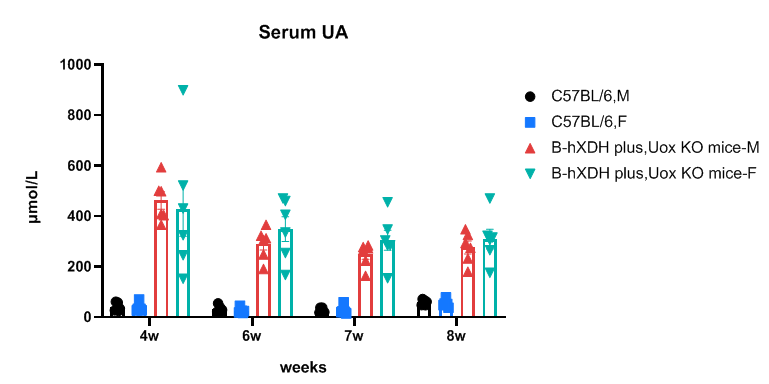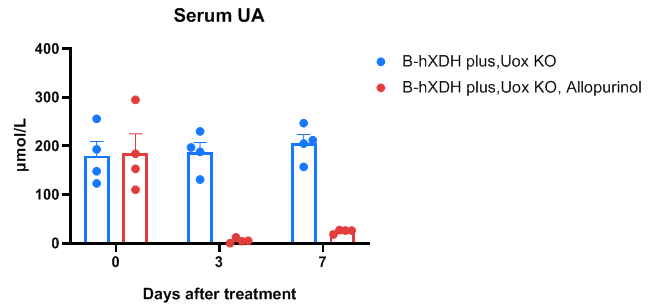B-hXDH plus, Uox KO mice
| Strain Name |
C57BL/6-Xdhtm2(XDH)Bcgen Uoxtm1Bcgen/Bcgen
|
Common Name | B-hXDH plus, Uox KO mice |
| Background | C57BL/6 | Catalog number |
113074 |
|
Related Genes |
XAN1, XO, XOR |
||
|
|
|
||
Description
- B-hXDH plus, Uox KO mice were obtained by mating B-hXDH mice plus (112642) and B-Uox KO mice (112758, delisting).
- Uric acid is the final metabolite of endogenous and dietary purine metabolism. Xanthine oxidase (XO) and xanthine dehydrogenase(XDH) which catalyze the oxidation of hypoxanthine to xanthine, and xanthine to uric acid, respectively, are interconvertible forms of the same enzyme. The enzymes are molybdopterin-containing flavoproteins that consist of two identical subunits of approximately 145 kDa. The enzyme from mammalian sources, including man, is synthesized as the dehydrogenase form, but it can be readily converted to the oxidase form by oxidation of sulfhydryl residues or by proteolysis. The exon 1 of mouse Xdh gene was replaced by human XDH CDS as well as human 5’UTR and human 3’UTR region in B-hXDH mice plus.
- Uox is a key enzyme that catalyzes the oxidation of uric acid to allantoin, thereby excreting uric acid from the body. Knockout of this gene can lead to severe obstruction of uric acid breakdown, resulting in severe hyperuricemia. The exons 3~4 of mouse Uox gene were knocked out in B-Uox KO mice.
Serum uric acid analysis

Serum uric acid analysis in wild-type C57BL/6 mice and B-hXDH plus, Uox KO mice. Serum was collected from wild-type C57BL/6 mice (+/+) and B-hXDH plus (H/H), Uox KO (-/-) mice (male and female) at 4, 6, 7, and 8 weeks. Compared with C57BL/6 mice, serum uric acid level of B-hXDH plus (H/H), Uox KO (-/-) mice was significantly increased. Values are expressed as mean ± SEM.
In vivo efficacy of Allopurinol

Efficacy validation in B-hXDH plus, Uox KO mice. Mice were divided into 2 groups (male, 7 weeks-old, n=4), treated with 100 μg/mL allopurinol in drinking water. Allopurinol could significantly reduce the serum uric acid level of B-hXDH plus, Uox KO mice at Day 3 and Day7. Values are expressed as mean ± SEM.









